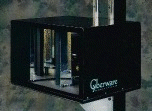 3.11. 2D and 3D Scanners
3.11. 2D and 3D Scanners  3.11. 2D and 3D Scanners
3.11. 2D and 3D Scanners A scanner is a series of charge coupled devices (CCDs) (an array of photosensitive cells) mounted in a stationary row that registers the presence or absence of light reflected from a piece of flat art. This spot of light is then the "pixel" equivalent of the dot on the paper. The entire scanned image is built up row by row as the light scans the paper and is reflected onto the CCD.
The number of pixels horizontally is controlled by how closely the CCDs are placed next to each other along the single row. The number of pixels vertically is controlled by how slowly the light bar and mirror inch along the length of the flat art thus reflecting onto the CCDs. Therefore, the more CCDs and the smaller the steps of the advancing light bar the greater the resolution. Typically the resolution available is 600 dots per inch for full colour( just 3 separate scans with filters).
Line Art scanning is simply transferring pen and ink style drawings, clip art, and some pencil sketches into the computer system. Line Art has no shading nor colour other than black. Line Art scanning is considered 1-bit scanning, that is the computer sees the image as either black or white.
Greyscale Scanning is most often used for original photographs, but can also be effective for maintaining the soft edge of some pencil sketches that use lots of shading. Most good flatbed desktop greyscale scanners are now capable of scanning 256 shades of grey.
Halftone Scanning is essentially a greyscale scan with processing to reduce the threat of moire patterns. (These are caused by the scan sampling interfering with the printing sampling due to the halftone printing process).
Colour Scanning is done on a continous-tone device in a non-screened system that is capable of applying the entire gamut of its colours to the smallest picture element that it can reproduce. In effect, this means that the device is capable of making any spot on its output any colour you wish.
For more information on scanning see http://www.infomedia.net/scan/The-Scan-FAQ.html
Cyberware manufactures a variety of instruments for 3-dimensional scanning. Pioneered by Cyberware, the laser and video-based technology can scan complex objects in only seconds. Cyberware makes standard and custom design laser scanners for many different applications. Some of these applications include industrial design, animation, anthropology, and medicine.
Cyberware's leading product quickly scans a person's head.
The scan produces a detailed three-dimensional dataset of the
facial features and a detailed texture map of the surface colour.
The Cyberware 3030RGB/PS Scanner is famous for its invaluable use
in animation and special effects. This scanner has played a role
in the movies Star Trek IV, The Abyss, Robocop II, Nightmare on
Elm Street, Terminator II, The Doors, Neuromancer, Batman II,
Jurassic Park, and many others.

Digitizes both shape and colour
Automatically scans objects under software control
Versatile design suits a wide range of applications
Scans an object in less than 30 seconds at 1x1-mm resolution
Creates a full-colour 3D model on a graphics workstation within seconds
after scanning
Works with both specialized and general-purpose Cyberware motion
platforms


Fig. 3.16 : 3030RGB Digitizing Head
The first 3D digitizer with colour capability, Cyberware's
Model 3030 delivers industry-leading performance for a variety of
applications. In less than a minute, the 3030 scans an object at
high resolution and shows you the resulting 3D image on a
graphics workstation - complete with true-to-life colour.
The availability of colour information to 3D digitizing provides nearly all the information a graphics application needs to fully describe an object. In addition to enhancing realism in graphic models, colour denotes boundaries that are not obvious from shape alone. Color indicates surface texture and reflectance. And by marking an object's surface before digitizing, you can use colour to transfer ideas from the object to the graphic model.
In specialized applications, colour can reveal characteristics such as skin discolouration, the grain of a piece of wood, or the locations of fasteners. Working in the infrared region, a customized colour subsystem can even detect surface temperature.
In operation, the 3030 shines a safe, low-intensity laser on an object to create a lighted profile. A high-quality video sensor captures the profile from two viewpoints. The system can digitize thousands of these profiles in a few seconds to capture the shape of the entire object. Simultaneously, a second video sensor in the 3030 acquires colour information.
The scanning process captures an array of digitized points, with each point represented by x, y, and z coordinates for shape and 24-bit RGB coordinates for colour. The 3030 transfers this data via SCSI to a graphics workstation for immediate viewing and modification.












